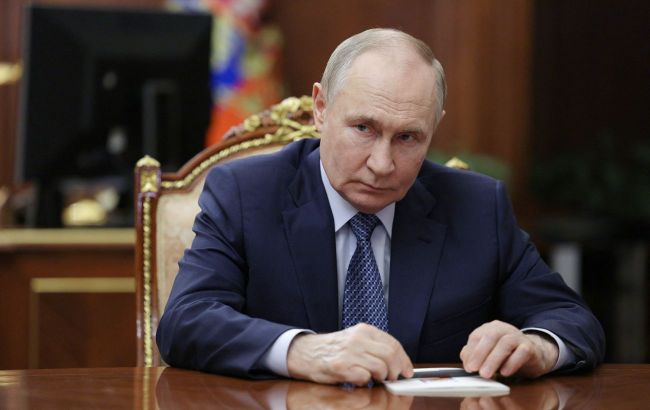Putin set to intensify strikes: Is Ukraine's power grid prepared?
 Vladimir Putin promises attacks on Ukrainian energy facilities (photo: Getty Images)
Vladimir Putin promises attacks on Ukrainian energy facilities (photo: Getty Images)
Russia resumed attacks on Ukraine’s energy infrastructure in August. Putin publicly stated that such attacks would continue and called on his partner, the Prime Minister of Slovakia, to cut off gas and electricity supplies.
RBC-Ukraine analyzed the potential risks of an energy crisis this winter.
After nearly a six-month pause, Russia renewed strikes on Ukraine’s energy facilities. The first attack is considered to be the strike on the SOCAR oil depot in the Odesa region on August 8. Following repairs, the facility was struck again on August 18, destroying all 17 storage tanks, the pumping station, and the operator and technical buildings.
According to unofficial reports from Azerbaijan, they indicated the possibility of lifting the arms embargo for Ukraine if the attacks continued. The latest information suggests there have been no further attacks on SOCAR facilities in Ukraine.
No serious fuel supply disruptions have occurred in Ukraine due to these attacks, according to Serhii Kuyun, Director of the A-95 Consulting Group. “Over 70 oil depots and all refineries were already hit in 2022–2023, and did anyone notice a fuel shortage? Thanks to market pricing, high competition, and a diversified import system, fuel is available and will continue to be at market prices,” Kuyun said.
Subsequent accurate strikes targeted the distribution of electrical grids across various regions, as well as gas transmission and extraction facilities. Regions affected included the Sumy, Poltava, Donetsk, Chernihiv, Kharkiv, Odesa, Zaporizhzhia, among others.
In some regions, consumers were partially or completely cut off from electricity and experienced water supply issues. Restoration of power in some areas took several days.
The risk of further strikes is significant. Russia no longer hides its intention to continue targeting energy facilities. Putin publicly mentioned this during a meeting with Slovak Prime Minister Robert Fico. “For a long time, several years ago, (Russia - ed.) did not take any actions against civilian infrastructure. Especially during the winter, we tolerated when Ukrainian troops continuously struck our energy facilities. After that, we began responding, and we are responding, of course, seriously," the Russian President said.
Furthermore, Putin asked Fico to organize an energy blockade of Ukraine: “Cut off their reverse-flow gas supplies, cut off their electricity supply - and they (Ukrainians - ed.) will immediately understand that there are limits to their behavior in violating others’ interests,” the Russian President told the Slovak Prime Minister.
 Russian President and Slovak Prime Minister Vladimir Putin and Robert Fico (photo: Getty Images)
Russian President and Slovak Prime Minister Vladimir Putin and Robert Fico (photo: Getty Images)
The claim that Russia had not attacked Ukraine’s energy sector for a couple of years is false. Attacks on gas extraction facilities at the end of last winter are well remembered. Gas production in Ukraine dropped by 40%, requiring a significant increase in imports. Earlier in the winter, Russia also carried out attacks on power generation facilities.
Russia appears to be striking Ukraine’s energy infrastructure in response to attacks on Russian refineries. In recent months, Ukrainian forces have indeed hit more than a dozen Russian oil-processing plants, taking up to 17% of their capacity offline. In August, Ukraine also struck the Druzhba oil pipeline multiple times, which led to a fuel shortage and rising gasoline prices in Russia.
President Zelenskyy stated on August 25 that Russia is attempting to disrupt Ukraine’s winter preparations. On September 1, Zelenskyy convened the Supreme Commander-in-Chief’s Staff meeting, with the main focus on preparing the energy sector for winter, including building fuel reserves, particularly gas, and increasing electricity generation.
The National Security and Defense Council of Ukraine was tasked with coordinating local authorities and energy companies to procure additional short- and medium-range air defense systems and increase drone production funding. Zelenskyy also reported that “further measures have been approved for the purchase of the necessary gas volumes.”
Exact details of these measures were not disclosed, but they likely involve securing additional financial resources and increasing imports, including new routes, such as from Azerbaijan.
In August, Ukraine conducted a trial import of Azerbaijani gas via the Trans-Balkan route and could continue imports this year if a contract is finalized.
Overall, the staff meeting did not produce any radical decisions regarding winter energy preparation. Multiple sources familiar with the results stated that energy companies reported positively on winter preparation, and the directives mostly repeat tasks from previous years, namely protecting facilities with air defense. “In practice, it’s just a declaration of what should have been done over the past two years - strengthening air defense,” one source said.
Companies were not required to allocate funds for protecting their facilities with air defense, and no decision was made to increase gas storage targets. Current reserves remain at 13.2 billion cubic meters - the minimum required under a positive scenario without considering severe attack impacts. If this winter is like last year, without extreme cold or attacks, there will be no problems.
 Ukrainian gas transmission system facility (photo: Getty Images)
Ukrainian gas transmission system facility (photo: Getty Images)
Last year, Ukraine entered the heating season with roughly the same gas reserves and passed it without major issues. The winter was mild, and energy facilities were not widely attacked. By February, gas extraction was already being targeted.
Consequently, the 2024/2025 heating season ended with minimal reserves - less than 1 billion cubic meters of active gas. Critical levels were not reached, and technological gas was untouched, although there was a risk if temperatures fell.
Thus, if this winter is similar to last, 13.2 billion cubic meters of gas will be sufficient.
However, given the risk of intensified strikes, more gas will be needed. Currently, storage facilities hold just over 11 billion cubic meters (including 4.5 billion cubic meters of technological gas), from imports and domestic production. Daily pumping rates are roughly balanced. Imports amount to about 24 million cubic meters per day, entering from Hungary, Poland, and Slovakia. On September 2, Poland supplied 10.1 million cubic meters, Hungary 9.7 million, Slovakia 3.8 million, while Romania has no deliveries yet, pending a contract with Azerbaijan.
At this pace, reaching the 13.2 billion cubic meters target by October is realistic. Financial resources for gas purchases are available - the national energy company has secured loans.
But if Putin implements his threats, energy needs will rise.
- First, if Russia damages extraction facilities, gas shortages will require withdrawals from storage, depleting reserves faster.
- Second, if compressor stations are damaged, imports must increase to compensate for reduced storage utilization.
- Third, if Slovakia cuts off reverse-flow gas per Putin’s request, import volumes will not be drastically affected. However, if Hungary joins, losses could be significant. If electricity supplies from Slovakia are cut, losses can likely be offset from Poland.
The government is fully aware of these risks and is working to increase both reserves and import capacity. “We expect more gas, but we are very cautious in our forecasts,” Energy Minister Svitlana Hrynchuk told RBC-Ukraine.
Hrynchuk added that the government is encouraging companies, including private ones, to purchase gas from partners. Negotiations are also ongoing with other countries to store gas in Ukrainian facilities. This gas would not be available for Ukraine’s use, but, combined with technological gas, would increase pressure in storage outputs, facilitating and reducing the cost of fuel withdrawals.
In addition, Ukraine could theoretically purchase temporarily stored gas if needed, providing an additional resource in a critical situation.
Sources familiar with the situation indicate that the upcoming winter may be much harsher than last. It will depend on the intensity of Russian strikes, the degree, and the nature of damage. However, a total blackout is unlikely, according to Hennadii Riabtsev, Director of the Psyche Center.
“Making the entire country powerless is no longer possible. This became clear several years ago,” Riabtsev said. Nonetheless, Russia could complicate the heating season by striking infrastructure, given the fragile balance of Ukraine’s energy system.

